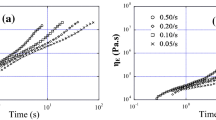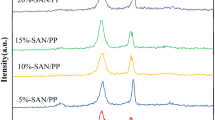Abstract
Three different synthesis strategies based on the in situ pre-polymerization process were employed in order to obtain High Impact Polystyrene (HIPS) with different type (morphology and size) of particles as the dispersed phase, achieved by the use of two styrene-butadiene rubbers (SBR) in the initial recipes. The rubbers used were tapered polystyrene/polybutadiene copolymers with a polystyrene/polybutadiene composition of 10/90 and 40/60 wt%. Results were discussed in terms of physical–chemical, morphological, mechanical and optical parameters. A combination of two or three types of particle morphologies, i.e. salami, core–shell and droplets in the same sample were evidenced by Transmission Electron Microscopy analysis, independently of the strategy employed. The grafting degree, volume fraction of the dispersed phase and impact strength were positively affected by the increase of the amount of 10/90 SBR in the recipe. Several HIPS samples showed a good balance between impact strength and gloss, particularly those obtained from the strategy herein named as melt blending.





Similar content being viewed by others
References
Aggarwal S, Livigni RA (1977) Structure and properties of microcomposites and macrocomposites from block polymers. Polym Eng Sci 17:498–505
Alfarraj A, Nauman EB (2004) Super HIPS: improved gigh impact polystyrene with two sources of rubber particles. Polymer 45:8435–8442
Amos JL (1974) Development of impact polystyrene—a review. Polym Eng Sci 14:1–11
Anzaldi S, Bonifaci L, Malaguti E, Vighi MG, Ravanetti P (1994) Some considerations on the second phase structure in high impact polystyrene and on the related measurement methods. J Mater Sci Lett 13:1555–1557
Baer M (1972) Studies on heterogeneous polymeric systems. I. Influence of morphology on mechanical properties. J Appl Polym Sci 16:1109–1123
Berkenwald E, Laganá ML, Maffi JM, Acuña P, Morales G, Estenoz D (2018) Experimental and theoretical study of the use of multifunctional initiators in the high impact polystyrene bulk process. Polym Eng Sci 58:198–212
Bowen KE, Hanner MJ (1999) In situ process for making a bimodal HIPS having both high gloss and high impact strength, U. S. 5,985,997
Chang L, Hu Y, Li Y, Shi Z, Li L, Wang Y (2012) Synthesis of high impact polystyrene via in situ bulk polymerization I. Effect of the initiator. China Synth Resin Plast 29:6–10
Cigna G, Matarrese S, Biglione GF (1976) Effect of structure on impact strength of rubber-reinforced polystyrene. J Appl Polym Sci 20:2285–2295
Cunha FR, Costa JM, Nele M, Folly ROM, Souza MB Jr, Pinto JC (2013) Influece of reaction operation conditions on the final properties of hich impact polystyrene (HIPS). Braz J Chem Eng 30:575–587
Dai R, Gao G, Zhang H (2010) Different deformation mechanisms of two modified-polystyrene bimodal systems. Polym Int 59:738–742
de Anda C, Morales G, Acuña P, Sosa J, Knoeppel D, Mays J (2010) Synthesis of HIPS using ab –a2B2 star type graft copolymer (PB-g-PS). Macromol React Eng 4:381–386
Demirors M, Schrader D, Black SM (1998) High gloss high impact monovinylidene aromatic polymers, E. P. 1,003,797
Díaz de León R, Morales G (2007) Evaluation of the interfacial state in high impact polystyrene through dynamic mechanical analysis as a function of the synthesis conditions. Polym Eng Sci 47:1827–1838
Díaz de León R, Morales G, Acuña P, Flores R, Montalvo A (2004) Efecto de los parámetros morfológicos sobre la tenacidad en poliestirenos modificados con hule. Revista Mexicana de Física 50:85–88
Díaz de León R, Morales G, Acuña P, Soriano F (2008) Mechanical behavior of high impact polystyrene based on SB copolymers as a function of synthesis conditions: Part II. e-Polymers 8(1):1–17
Díaz de León R, Morales G, Acuña P, Soriano F (2009) Phenomenon of phase inversion in high impact polystyrene: physico-chemical, rheological and morphological study in the presence of chain transfer agent and using different tapered block copolymers as the precursor rubber. Polym Eng Sci 50(2):373–383
Díaz de León R, Morales G, Acuña P, Soriano F (2010) Phenomenon of phase inversion in high impact polystyrene: physico-chemical, rheological and morphological study in the presence of chain transfer agent and using different tapered block copolymers as the precursor rubber. Polym Eng Sci 50:373–383
Donald AM, Kramer EJ (1982) Craze initiation and growth in high-impact polystyrene. J Appl Polym Sci 27:3729–3741
Dupre CR (1979) Method for preparing a monoalkenyl aromatic polyblend having a dispersed rubber phase as particles with a bimodal particle size distribution, U. S. Patent 4,146,589
Echte A (1989) Rubber-toughened styrene polymers, in rubber-toughened plastics. Ed. Keith Riew C 222:15–64
Enríquez-Medrano FJ, Hernández-Valdez M, Maldonado-Textle H, Lacroix-Desmazes P, Guerrero-Santos R (2012) Super impact strength of blends prepared from regular HIPS and poly(butyl acrylate)-block-poly(styrene) obtained by RAFT polymerization. Polym Adv Technol 23:375–381
Freeguard GF (1972) Rubber modified polystyrene: structural variation induced during pre-polymerization. Polymer 13:366–370
Hanifpour A, Bahri-Laleh N (2019) Effects of the molecular weight and C=C functionality of poly 1-hexene on the properties of poly 1-hexene-based high impact polystyrene. J Appl Polym Sci, 1–8. Article ID 47169
Hobbs SY (1986) The effect of rubber particle size on the impact properties of high impact polystyrene (HIPS) blends. Polym Eng Sci 26:74–81
Katime A, Quintana J, Price C (1995) Influence of the microstructural morphology on the mechanical properties of high-impact polystyrene. Mater Lett 22:297–301
Laganá ML, Berkenwald E, Acuña P, Enríquez Medrano J, Morales G, Estenoz D (2019) New advances in the mathematical modeling of the continuous bulk process for the production of high-impact polystyrene using multifunctional initiators. Polym Eng Sci 59:E231–E246
Lanza E (1979) High-impact polystyrene and process for the production thereof. U. S. 4(153):645
Lavengood RE (1980) Method for preparing a monoalkenyl aromatic polyblend having a dispersed rubber phase as particles with a bimodal particle size distribution. U. S. Patent 4,214,056
Leal GP, Asua JM (2009) Evolution of the morphology of HIPS particles. Polymer 50:68–76
Li D, Peng J, Zhai M, Qiao J, Zhang X, Wei G (2008) Novel methods for snthesis of high-impact polystyrene with bimodal distribution of rubber particle size. J Appl Polym Sci 109:2071–2075
Li T, Li L, Xu Q, Wang Y, Li Y (2016) Synthesis and mechanical properties of high impact polystyrene with in situ bulk polymerization toughened by one-pot Nd-based styrene-isoprene-butadiene terpolymer rubber. J Appl Polym Sci, 1–8. Article ID 43979
Luciani CV, Estenoz DA, Meira GR, García NL, Oliva HM (2007) Bulk high-impact polystyrene process, 1 partitions of tert-butyl peroctoate and styrene in blends containing polystyrene and rubber. Macromol Theory Simul 16:703–710
Maffi JM, Casis N, Acuña P, Morales G, Estenoz DA (2020) Mechanisms and conditions that affect phase inversión processes. The case of high-impact polystyrene. Polym Eng Sci 60:491–502
Morales G, Díaz de León R, Acuña P, Flores Flores R, Montalvo Robles A (2006) Improved toughness in HIPS obtained from different styrene/butadiene-graded block copolymers through modification of the polydispersity index of the PS block. Polym Eng Sci 46:1333–1341
Nazari D, Bahri-Laleh N, Nekoomanesh-Haghighi M, Mehrdad Jalilian S, Rezaie R, Mirmohammadi SA (2018) New high impact polystyrene: use of poly(1-hexene) and poly(1-hexene-co-hexadiene) as impact modifiers. Polym Adv Technol 29:1603–1612
Okamoto Y, Miyagi H, Kakugo M, Takahashi K (1991) Impact improvement mechanism of HIPS with bimodal distribution of rubber particle size. Macromolecules 24:5639–5644
Perkins HL, Wilson RW (2000) High gloss, high impact polystyrene composition. U. S. Patent 6,011,117
Sardelis K, Michels HJ, Allen G (1987) Toughened polystyrene containing block, graded block and randomized copolymers of butadiene-styrene. Polymer 28:244–250
Schrader D, Soderquist ME, Heire MD (1995) U. S. Patent 5,428,106
Sheu H-R (2002) High impact resistant, high gloss, and high environmental stress crack resistant polymeric compositions, U. S. Patent 6,380,305
Silberberg J, Han CD (1978) The effect of rubber particle size on the mechanical properties of high-impact polystyrene. J Appl Polym Sci 22:599–609
Soto G, Nava E, Rosas M, Fuenmayor M, Gonza IM, Meira GR, Oliva HM (2004) Bulk polymerization of styrene in the presence of polybutadiene: effect of initiator type and prepolymerization conditions on particle morphology. J Appl Polym Sci 92:1397–1412
Taylor GI (1934) The formation of emulsions in definable fields of flow. Proc Roy Soc Lond Ser A 146:501–523
Vonka M, Seda L, Kosek J (2011) Modelling of the high-impact polystyrene morphogenesis. Macromol Symp 302:151–160
Wagner ER, Robeson LM (1970) Impact polystyrene: factors controlling the rubber efficiency. Rubber Chem Technol 43:1129–1137
Wang F, Chang L, Hu Y, Wu G, Liu H (2019) Synthesis and properties of in-sity bulk high impact polystyrene toughened by high cis-1,4 polybutadiene. Polymers 11:791–801
Wrotecki C, de Charentenay FX (1988) The effect of a bi-population of particle size on the impact properties of HIPS. Deform Yield Frac Polym 7: 51/1–51/3
Yenalyev VD, Noskova NA, Melnichenko VI, Bovkunenko OP, Bulatova VM (1983) On the influence of the initial stages of styrene copolymerization with polybutadiene on high impact polystyrene morphology. Polym Alloys III Polym Sci Technol Book Ser 20:39–44
Acknowledgements
The authors of this paper would like to thank CONACyT (Consejo Nacional de Ciencia y Tecnología, México) for the financial support of this research. To Alejandro Díaz, Jesús Cepeda and Alejandro Espinoza by their technical support in the characterization of the samples.
Funding
This work was supported by the National Council of Science and Technology in Mexico (CONACyT).
Author information
Authors and Affiliations
Corresponding author
Ethics declarations
Conflict of interest
No potential conflict of interest was reported by the authors.
Additional information
Publisher's Note
Springer Nature remains neutral with regard to jurisdictional claims in published maps and institutional affiliations.
Rights and permissions
About this article
Cite this article
Enríquez-Medrano, F.J., Acuña, P. & Morales, G. Synthesis strategies in the preparation of high impact polystyrene with different type of particles as the dispersed phase, towards a balance between impact strength and gloss. Braz. J. Chem. Eng. 37, 715–727 (2020). https://doi.org/10.1007/s43153-020-00040-y
Received:
Revised:
Accepted:
Published:
Issue Date:
DOI: https://doi.org/10.1007/s43153-020-00040-y




